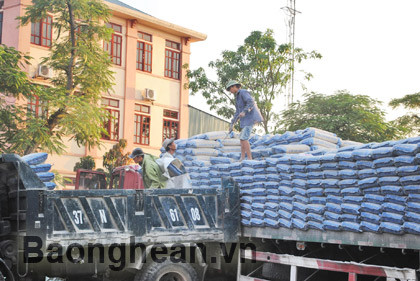Strengthening the handling of oversized and overloaded vehicles
(Baonghean) -Since September 4, traffic police forces across the province have simultaneously stepped up patrols and controlled the handling of oversized and overloaded vehicles to restore traffic safety and order.
National Highway 7 is over 250 km long from Dien Chau district to Ky Son, with Nam Can border gate and Tam Hop border gate. The volume of timber transported from Laos through these border gates is very large. The road to Tam Hop border gate has been invested by the State with thousands of billions of VND, but hundreds of timber trucks have "plowed" and severely damaged this road. In addition, the section from Nam Can to Anh Son district has been upgraded with nearly 3,000 billion VND, but overloaded timber trucks and construction material trucks serving the Khe Bo Hydropower, Nam Mo Hydropower, and Nam Non Hydropower projects have caused subsidence and deterioration of bridges and culverts on the route.
Mr. Nguyen Duc Vinh - Deputy Head of Traffic Police Team 1-7 said: Vehicles carrying wood from Laos mainly run from 2-3 am, following Ho Chi Minh road or National Highway 7. The team has arranged forces to stay at checkpoints and request the vehicles to be brought back to the unit's headquarters to unload. Up to this point, the team has handled over 100 overloaded vehicles, including 90 cases of overloaded vehicles, over 10 oversized vehicles.

Unloading cement at Traffic Police Team 1-5
It is known that, due to the determination of the police force, many trucks carrying wood have temporarily stopped, however, some trucks carrying construction materials and machinery for hydroelectric projects are mostly violating overloading regulations. Traffic Police Team 1-7 is actively checking and resolutely handling the situation, forcing them to reduce their load before allowing them to circulate.
On National Highway 1A, the volume of "oversized" and "overweight" vehicles has been quite high for a long time, causing many sections to sink miserably. For example, the section from Cau Cam (Nghi Loc) to Dien An Commune (Dien Chau) has a bumpy and "undulating" road, and many cars have crashed into these potholes and caused accidents. At the headquarters of Traffic Police Team 1-5, we saw vehicles jostling each other waiting to unload. Up to this point, the Team has handled 305 overloaded vehicles, forced 110 vehicles to unload, and paid the State budget over 700 million VND. However, after being asked to bring their vehicles to the headquarters, some truck drivers left, leaving their vehicles on the side of the road without cooperating with the police force.
Lieutenant Colonel Cao Minh Phuong - Deputy Head of the Provincial Traffic Police Department added: In handling oversized and overloaded vehicles, the traffic police force has to endure a lot of pressure, due to the reactions and complaints of transport businesses, and even drivers who have not cooperated to reduce their load. Not to mention that the teams do not have stations, or the stations are too cramped to temporarily detain oversized and overloaded vehicles; they are not equipped with weighing stations or electronic scales to determine the weight of the vehicle; the force is still thin. Many overloaded vehicles have run at night, temporarily taking refuge on residential roads to wait for a chance to "escape", making it difficult to handle and detect.
In addition, currently, the fine for oversized and overloaded vehicles according to Decree 34/CP on administrative penalties for violations in the field of road traffic is still low, so it is not enough of a deterrent. Specifically, vehicles carrying oversized and overweight goods without marking the size of the goods according to regulations are fined from 3 to 5 million VND, so vehicle owners accept to pay the fine quickly to continue carrying goods.
Faced with the above situation, to thoroughly handle oversized and overloaded vehicles, in addition to patrolling, controlling and handling by the police force, the Transport sector needs to build more weighing stations and yards at locations to offload; strengthen propaganda for vehicle owners, and inspect vehicles right from when they enter the area. In addition to the spearhead force of the police, it is very necessary to have synchronous coordination with localities and related functional sectors in inspection and handling.
Van Truong
